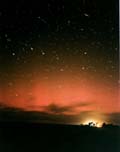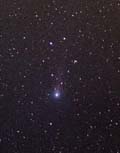
Photo Gallery
Astronet welcomes photographs or illustrations of astronomical phenomena. Please submit your pictures, too!
All images remain copyrighted by the photographers.
| Photographer/artist | Images | Comments | |
 |
Christine Churchill, Kenwood, California, USA | #1 |
Christine Churchill took this lovely picture of the "Full Moon, Rising in the Valley of the Moon" on
January 18, 2003--6:08 PST, with a Sony 4.1 camera (afocal photography) and her homemade Dobsonian 10" telescope--40mm eyepiece-
shutter speed 1/500--aperture 2.8. The beautiful picture was selected by Sky & Telescope for publication in its May issue, 2003. Congeatulations, Christine! Christine is Vice President of the Sonoma County Astronomical Society, Santo Rosa, California. |
 |
Christine Churchill, Kenwood, California, USA | #1 |
Christine Churchill made this interesting picture of a cloud during sunset. Christine adds: "Clouds can make imaginary shapes and appear most dramatic at Sunset. In this picture, low horizon clouds make it appear as hot lava, flowing across the distant land. The last blast of the Sun seems to explode back into the darkening sky. One cloud remains above this dramatic scene looking much like a spaceship ready to land and seek out this new world." The atmospheric phenomenon was photographed at sunset July 12, 02. Condition: Weather change from a hot day 110 degrees. Camera: Sony Mavica digital 2.1. Christine is Vice President of the Sonoma County Astronomical Society, Santo Rosa, California. |
 |
Arjen and Jan l'Amie, Alphen a/d Rijn, The Netherlands |
gif (397 kB) |
Arjen and Jan l'Amie took this video of a Quadrantid meteor in Gemini in January 3, 2002. They used a Ikegami CCD-camera with 50 mm lens and a time-lapse videorecorder. |
 |
John van Raak, Chaam, The Netherlands |
mpeg (712 kB) |
John van Raak made this mpeg of a halo at different elevations of the Sun
using the Halo-3 simulation program by Les Cowley
(Atmospheric Optics) and Michael Schroeder.
The mpeg starts with the Sun 5o below the horizon and continues to an elevation of 50o
above the horizon. Halos occur more frequently than rainbows. In Europe and parts of the United States they can be seen on average twice a week . The 22° radius circular halo is usually the most frequent followed by parhelia (sun dogs) and then the upper tangent arc. Passing through the sun dogs, and sometimes encircling the whole sky at the same altitude as the sun, is a parhelic circle. Upper and lower tangent arcs touch the 22° halo directly above and below the sun. A circumzenithal arc is high above all. |
 |
John van Raak, Chaam, The Netherlands | #1, #2 |
John van Raak took these pictures on a hot summer day in July 2001.
They show sixfold highway mirages. A layer of hot air above the dry pavement refracts light rays
from the bright blue sky, causing an illusion of water. Both highway and desert mirages are inferior
mirages. The adjective inferior refers to the position of the perceived image -- below or inferior -- in relation to the
actual position of the object. John van Raak took these photographs with his Meade Schmitt-Cassegrain 1000mm f/10 on highway near his residence Chaam. Mirages are quite common there, according to John van Raak. |
 |
Christine Churchill, Kenwood, California, USA | #1 |
Christine Churchill used a Sony Mavica 1000 (2,1-mega pixels camera)
to capture the vineyards in the morning fog. The picture was taken November 21, 2001 at
at 7:31:am PST in Kenwood California, known as the Valley of the Moon. The image displays the so
called Belt of Venus,
a slightly pink part of the atmosphere above the horizon, in the direction opposite the Sun.
It can be seen during a cloudless twilight. The dark band below is part of the sky still in
the Earth's shadow. The bright sky above to the right is normal sunlight reflecting off the
atmosphere. In the Belt of Venus the atmosphere reflects light from the setting (or rising)
Sun which appears reddish. Christine is Vice President of the Sonoma County Astronomical Society, Santo Rosa, California. |
 |
Arnold Tukkers, Lattrop, The Netherlands | #1, #2 | Arnold Tukkers of Cosmos Sterrenwacht travelled to China to watch the 2001 maximum of the Leonid meteor shower. These are two of his pictures taken with a fisheye lens. The first one shows two meteors of magnitude -5 The second picture shows meteors of magintude -5 and -3 in the constellation of Orion. |
 |
Ton Schoenmaker, Roden, The Netherlands | #1 | Not a picture but a very valuable observation. Ton Schoenmaker of Stichting ASTRON (Netherlands Foundation for Research in Astronomy) recorded two distinct maxima of the 2001 Leonid metor shower. Although The Netherlands were heavily overcasted, Ton Schoenmaker precisely recorded the Leonid intensity by means of radio observations. Meteors leave an ionised trail in the atmosphere. This trail can forward scatter signals from radio or TV broadcasting stations transmitters from "behind" the horizon. Ton Schoemnaker listened to a 55.275 MHz TV station in Spain and used a scanner with 3-elements yagi as receiver. The reflections by the meteors were autmatically recorded in his PC. |
 |
Andrew Chatmann, Pittsford, New York, USA | #1, #2, #3, #4 | Andrew Chatman took these stunning pictures of the 2001 Leonids. Details: Shot with an Olympus E20 on a tripod with cable remote control, 25 second exposures, ISO 80, White Balance 6500K, F/2.0. Dark frame subtraction in Photoshop used to reduce noise. Shooting location: Pittsford, NY (suburb of Rochester). Shooting time: 4:15 - 6:00 EST |
 |
Christine Churchill, Kenwood, California, USA | #1 | The September 2, 2001 Full Moon captured by Christine Churchill. The bright light of the Full Moon scattered by the atmosphere tends to mask the stars in its its surroundings. However, composite images can be made that show both the Full Moon and the stars. |
 |
Maurice Gavin, London, UK | #1 | The aurora of October 21, 2001 was also captured at 21:20 UT from the Worcester Park Observatory in London by Maurice Gavin. Maurice Gavin's homepage also displays pictures of recent solar and lunar eclipses. |
 |
Rijk-Jan Koppejan, Zeeland, The Netherlands | #1 | On 19 October, 2001 twisted magnetic fields above sunspot 9661 erupted powerfully -- not once, but twice -- at 0105 UT and again at 1640 UT. Both explosions unleashed category X1.6 solar flares and hurled lopsided coronal mass ejections (CMEs) toward Earth. The expanding clouds stroke Earth's magnetosphere on Oct. 21st. Rijk-Jan Koppejan of Volkssterrenwacht "Philippus Lansbergen", Middelburg, The Netherlands, took this picture from Vrouwenpolder in Zeeland, The Netherlands. |
 |
Marco Verstraaten, St. Annaparochie, The Netherlands | #1, #2 |
IMPACT! An interplanetary shock wave buffeted Earth's magnetosphere on
Monday, August 27th, and triggered auroras across Canada and the northern United States.
On 28 October 01:00 a.m. local time the aurora was also visible from The Netherlands
where it was captured by Marco Verstraaten above the Waddensea north of the province of
Friesland. Exposure 3 minutes on Fuji Superia 400, 28mm, f 2.8 lens. The aurora is seen
below the Big Dipper. To the right shines the lighthouse of Ameland island. In the
upper right corner a tiny 'meteor'is visible. This is the flash of an Iridium satellite.
Picture #2 shows the clouds coming in. This picture has as shorter exposure time of 1 minute. Marco Verstraaten has been an ardent astrophotographer for 9 years already. More of his beautiful pictures are displayed on his homepage AstroPage. |
 |
Marco Verstraaten, St. Annaparochie, The Netherlands | #1 | Marco Verstraaten captured Comet Linear 2001 A2 on 17 July 2001 using a 300 mm. f 5.6 telephotolens and Konica Centuria 400. More images of jis images of comets, including Hale-Bopp and Hyakutake, can be found on the comets & meteors section of his homepage AstroPage. |